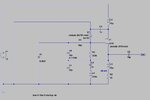andrea_mori
Member level 2

Attached the circuit I'm using successfully with 3rd overtone crystal at 45.1584 Mhz (C1=C2=22 pF, L3=2.7uH).
I'm trying to use it at 90.3168 MHz, using a 5th overtone crystal, but it doesn't start at the right frequency.
C1 and C2, scaled to 12 pF, show the same reactance, C2 and L3 are tuned around 60 MHz, so they look inductive at 3rd overtone but still capacitive a 5th overtone.
45 Mhz crystal has the following specs:
mode: 3rd overtone
ESR: 15 ohm
motional capacitance: 1.2 fF
Q: 200k
while 90 MHz crystal specs are:
mode: 5th overtone
ESR: 35 ohm
motional capacitance: 0.36 fF
Q: 135k
So, the relevant difference between the two crystal is the ESR, 15 ohm against 35 ohm.
Seems there isn't enough gain to start.
Any help?
I'm trying to use it at 90.3168 MHz, using a 5th overtone crystal, but it doesn't start at the right frequency.
C1 and C2, scaled to 12 pF, show the same reactance, C2 and L3 are tuned around 60 MHz, so they look inductive at 3rd overtone but still capacitive a 5th overtone.
45 Mhz crystal has the following specs:
mode: 3rd overtone
ESR: 15 ohm
motional capacitance: 1.2 fF
Q: 200k
while 90 MHz crystal specs are:
mode: 5th overtone
ESR: 35 ohm
motional capacitance: 0.36 fF
Q: 135k
So, the relevant difference between the two crystal is the ESR, 15 ohm against 35 ohm.
Seems there isn't enough gain to start.
Any help?








